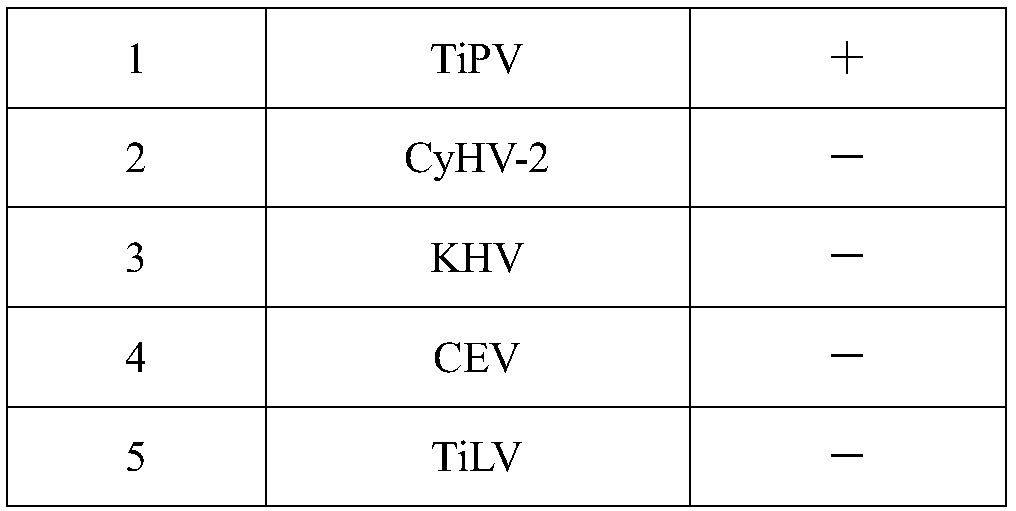TiPV and PCR detection primer for tilapia parvovirus and application
A parvovirus, tilapia technology, applied in the direction of virus, virus/phage, single-stranded DNA virus, etc., can solve the problems of tilapia breeding and export economic loss, tilapia death, etc., to ensure high specificity, The method is quick and easy, and the effect is highly specific
- Summary
- Abstract
- Description
- Claims
- Application Information
AI Technical Summary
Problems solved by technology
Method used
Image
Examples
Embodiment 1
[0024] TiPV, a kind of tilapia parvovirus, is separated as follows:
[0025] 1) After removing the virus-carrying tilapia spleen, kidney and other tissues and milling, the medium is diluted 100 times, centrifuged at 2000 rpm, and the supernatant is filtered and inoculated into the tilapia kidney cell line (TilapiaKidney, TiK) monolayer. Culturing for 7 days at 25°C produced a cytopathic effect (CPE). It can be seen that TiK cells contracted and rounded, the refractive index increased, some cells began to fall off, and the cell monolayer began to break.
[0026] Medium: M199, 10% fetal bovine serum, pH 7.0~7.2
[0027] 2) Collect diseased cells and use transmission electron microscopy for morphological identification.
[0028] 3) The virus is collected and sequenced to obtain the specific gene of tilapia parvovirus TiPV, which is shown in SEQ ID NO.1.
[0029] Morphological characteristics of tilapia parvovirus: The virus has a spherical shape and has no envelope, which is consistent wi...
Embodiment 2
[0031] Primers designed based on the difference between the specific gene of tilapia parvovirus TiPV (shown in SEQ ID NO.1) and other viral genes:
[0032] Including F1: 5'-TATCCAGTCCCGACCTACTCAAA-3', R1: 5'-AGTTAAAACTAATCGCGTTCTTCCC-3'; F2: 5'–CACGTTAAGGGCGTATCGTGTAA-3', R2: 5'-TATCTGCTGCTGTTGGTGTTGGT-3'.
Embodiment 3
[0034] The detection of tilapia parvovirus using TiPV PCR primers includes:
[0035] 1. Extraction of total DNA from tilapia tissue or infected cells: Use Omega (USA) DNA extraction kit to extract tissue DNA.
[0036] 2. Polymerase chain reaction amplification:
[0037] Using 25μl reaction system: In the PCR reaction tube, add 10μM primers F1 and R1 each plus 1μl, then add 2.5mMdNTPs 2μl, 25mM MgCl 2 1.5μl, 5U Taq polymerase 0.5μl, template DNA 1μl, 10×Thermo PolReaction Buffer 2.5μl, fill up the system to 25μl with sterilized double distilled water, and perform PCR reaction.
[0038] Using the reaction product as a template, take 1μl, 10μM primers F2 and R2 and add 1μl each, then add 2μl 2.5mM dNTPs, 25mM MgCl21.5μl, 5U Taq polymerase 0.5μl, 10×ThermoPol Reaction Buffer 2.5μl, and sterilize Double distilled water to make up the system to 25μl, and perform PCR reaction.
[0039] Reaction conditions: 95°C pre-denaturation for 5 minutes; 95°C for 30s, 55°C for 30s, 72°C for 30s, 30 cycl...
PUM
 Login to View More
Login to View More Abstract
Description
Claims
Application Information
 Login to View More
Login to View More - R&D
- Intellectual Property
- Life Sciences
- Materials
- Tech Scout
- Unparalleled Data Quality
- Higher Quality Content
- 60% Fewer Hallucinations
Browse by: Latest US Patents, China's latest patents, Technical Efficacy Thesaurus, Application Domain, Technology Topic, Popular Technical Reports.
© 2025 PatSnap. All rights reserved.Legal|Privacy policy|Modern Slavery Act Transparency Statement|Sitemap|About US| Contact US: help@patsnap.com


